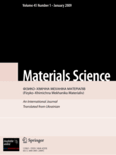
MATERIALS SCIENCE
Scope & Guideline
Pioneering Discoveries in Condensed Matter Physics.
Introduction
Aims and Scopes
- Metallurgical Processes and Materials Engineering:
Research related to the processing, structure, and properties of metals and alloys, including studies on welding, heat treatment, and alloy design. - Corrosion and Degradation Studies:
Investigations into the corrosion behavior of various materials, including steels, aluminum alloys, and composites, under diverse environmental conditions. - Nanomaterials and Advanced Coatings:
Studies focusing on the synthesis, characterization, and application of nanostructured materials and coatings for enhanced performance in various applications. - Mechanical and Tribological Behavior:
Research that explores the mechanical properties, wear resistance, and tribological characteristics of materials, particularly under different loading conditions. - Biomaterials and Environmental Applications:
Investigations into the development and application of materials for biomedical uses and their environmental impact, including studies on biodegradable materials and eco-friendly corrosion inhibitors. - Computational Materials Science:
Utilization of computational methods and modeling to predict material behavior, optimize processing conditions, and understand microstructural evolution.
Trending and Emerging
- High-Entropy Alloys and Advanced Alloys:
There is a growing interest in high-entropy alloys, which exhibit unique properties due to their complex compositions, leading to innovative applications in various industries. - Hydrogen Effects on Materials:
Research focusing on the interactions between hydrogen and materials, including hydrogen embrittlement and hydrogen storage, is increasingly prominent due to its implications for energy and materials integrity. - Sustainable and Eco-Friendly Materials:
A trend towards developing sustainable materials, including biodegradable polymers and eco-friendly corrosion inhibitors, is becoming more significant in response to environmental concerns. - Smart and Functional Materials:
The emergence of smart materials that respond to environmental stimuli and have multifunctional capabilities is a growing area of research, encompassing applications in sensors and actuators. - Additive Manufacturing and 3D Printing:
Research related to additive manufacturing techniques, particularly for metals and composites, is on the rise as industries seek to leverage these technologies for rapid prototyping and customized solutions.
Declining or Waning
- Traditional Composites:
Research on conventional composite materials has decreased as focus shifts towards advanced composites and nanocomposites, which offer superior properties and new applications. - Basic Mechanical Testing:
While fundamental mechanical testing remains important, there is a noticeable decline in studies solely focused on basic mechanical properties without integrating advanced analysis or applications. - Low-Tech Applications of Materials:
Research that emphasizes low-tech applications, such as simple structural uses of materials, has waned in favor of high-tech applications that involve innovative technologies and methodologies. - Corrosion Resistance of Standard Alloys:
The exploration of corrosion resistance in well-established standard alloys is less prevalent, as researchers now prioritize novel alloys and composites with tailored properties for specific environments.
Similar Journals

METALLURGICAL AND MATERIALS TRANSACTIONS A-PHYSICAL METALLURGY AND MATERIALS SCIENCE
Bridging Theory and Application in Metallurgical ResearchMETALLURGICAL AND MATERIALS TRANSACTIONS A - PHYSICAL METALLURGY AND MATERIALS SCIENCE, published by Springer, is a prestigious journal that plays a pivotal role in advancing the fields of physical metallurgy and materials science. With an ISSN of 1073-5623 and an E-ISSN of 1543-1940, this American journal provides a vital platform for disseminating cutting-edge research and innovative findings relevant to condensed matter physics, mechanics of materials, and metals and alloys. The journal, indexed with an impressive Q1 ranking in multiple categories in 2023, ensures its position among the top-tier publications, making it an essential resource for researchers, professionals, and students alike. Spanning decades of invaluable contributions since its inception in 1975, METALLURGICAL AND MATERIALS TRANSACTIONS A focuses on fostering academic dialogue, promoting collaboration, and showcasing leading-edge discoveries that drive the materials science community forward. Researchers seeking to publish their work in a highly visible forum will find this journal an optimal choice for reaching a discerning audience.
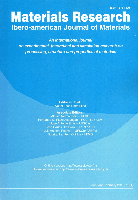
Materials Research-Ibero-american Journal of Materials
Advancing materials science through inclusive knowledge sharing.Materials Research-Ibero-american Journal of Materials, published by the UNIV FED SAO CARLOS, DEPT ENGENHARIA MATERIALS, is a prominent platform dedicated to advancing the field of materials science. Launched in 1998, this Open Access journal has fostered a culture of inclusive knowledge sharing, allowing researchers and practitioners worldwide to access valuable insights in Condensed Matter Physics, Materials Science, Mechanical Engineering, and Mechanics of Materials. With a commendable Q3 ranking in these diverse categories in 2023, the journal provides a vital resource that bridges theoretical research and practical applications in materials technology. Covering a range of topics from novel material characterization to innovative engineering solutions, Materials Research serves as a critical forum for contributors across the globe, particularly those in Latin America. Researchers, students, and professionals are encouraged to engage with this journal, which operates with a clear commitment to high standards and is based in São Carlos, Brazil, further enhancing its relevance and appeal within the international materials research community.
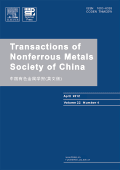
TRANSACTIONS OF NONFERROUS METALS SOCIETY OF CHINA
Fostering excellence in materials science and engineering.TRANSACTIONS OF NONFERROUS METALS SOCIETY OF CHINA, published by Elsevier, is a premier academic journal that serves as a vital platform for researchers and professionals specializing in materials science, condensed matter physics, geotechnical engineering, and engineering geology. Established in 1994, this esteemed publication has maintained a robust focus on the latest developments in the nonferrous metals sector, reflecting its significant impact in the field with a Q1 categorization across multiple disciplines. With impressive Scopus rankings—placing it in the top 20% of journals in relevant categories—this journal is recognized for its quality and rigor, providing critical insights into metals and alloys, materials chemistry, and their applications. The non-open access format ensures a dedicated readership among professionals and academics seeking substantial and authoritative research articles. By fostering knowledge exchange, the journal strives to advance the understanding and application of nonferrous metals, making it an essential resource for anyone involved in material innovations and engineering solutions.

Obrabotka Metallov-Metal Working and Material Science
Empowering Discoveries in Mechanical EngineeringObrabotka Metallov-Metal Working and Material Science is a pivotal journal published by Novosibirsk State Technical University, focusing on the dynamic fields of mechanical engineering, mechanics of materials, and the science of metals and alloys. With ISSN 1994-6309 and E-ISSN 2541-819X, the journal serves as a crucial platform for disseminating research from Russia and around the globe. Currently classified in the Q4 category for Mechanical Engineering and Mechanics of Materials, as well as Q3 for Metals and Alloys, it encompasses a wide range of studies from fundamental research to innovative applications. Despite its relatively recent inception in 2019, the journal has established itself with Scopus rankings that highlight its growing influence—Rank #122 out of 176 in Materials Science and Rank #510 out of 672 in Engineering. This journal aims to foster collaboration among researchers, professionals, and students by featuring original articles, reviews, and technical notes that address contemporary challenges in metal processing and material science. As it continues to evolve through 2024, Obrabotka Metallov remains dedicated to enhancing the understanding and application of materials science, making it a significant resource for those invested in the future of engineering and technology.
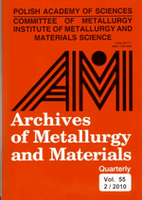
ARCHIVES OF METALLURGY AND MATERIALS
Connecting Knowledge and Innovation in MetallurgyArchives of Metallurgy and Materials is a prestigious open-access journal published by the Polish Academy of Sciences, Institute of Metallurgy and Materials Science. With its ISSN 1733-3490 and E-ISSN 2300-1909, this journal has been a critical resource for researchers and professionals in the field of materials science since its establishment in 2004. The journal focuses primarily on advancements in metals and alloys, contributing to the growing body of knowledge in this dynamic and evolving discipline. As acknowledged in the 2023 Scopus rankings, it currently holds a Q3 category in both Metals and Alloys with a rank of #117 out of 176 journals, indicating its commitment to quality research despite being relatively young in the indexing landscape. With its open-access policy initiated in 2010, the journal aims to enhance the dissemination of scientific findings and encourage collaboration among the global materials science community. Researchers, students, and industry professionals are invited to explore the valuable insights and innovations showcased within Archives of Metallurgy and Materials, contributing to the advancement of material technologies and applications.

Metals
Advancing metallurgical knowledge for a sustainable future.Metals is an esteemed open access journal published by MDPI, focusing on the diverse field of metallurgical science and its applications. Since its inception in 2011, the journal has provided a platform for the dissemination of high-quality research regarding the behavior, processing, and properties of metals and alloys. With an E-ISSN of 2075-4701, it has quickly established itself within the scientific community, achieving a remarkable Q1 ranking in the realm of Metals and Alloys and a Q2 rank in general Materials Science as of 2023. The journal is situated in Switzerland and is committed to the principles of open access, ensuring that findings are accessible to a broad audience without subscription barriers. With its notable impact factor and a strong emphasis on innovative research, Metals serves as an essential resource for researchers, professionals, and students seeking to advance their knowledge and understanding in the ever-evolving landscape of metallurgical studies.
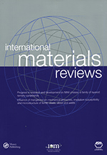
INTERNATIONAL MATERIALS REVIEWS
Advancing Knowledge in Materials Chemistry and EngineeringINTERNATIONAL MATERIALS REVIEWS, published by SAGE Publications Inc, is a leading journal dedicated to the comprehensive analysis of contemporary research in the fields of materials chemistry, mechanical engineering, mechanics of materials, and the study of metals and alloys. With an impressive impact factor and a Q1 ranking across multiple categories such as Materials Chemistry and Mechanical Engineering in 2023, it ranks amongst the top journals for innovative materials research. The journal has a long-standing history since its inception in 1987 and continues to serve as a crucial resource for academics and professionals alike. Although it is not open access, it is renowned for its rigorous peer-review process and its commitment to disseminating high-quality materials science research globally. Researchers, students, and industry professionals benefit greatly from the journal's insightful reviews, both for the advancement of theoretical knowledge and practical applications within the fast-evolving materials field.

International Journal of Surface Science and Engineering
Exploring the Frontiers of Surface InnovationThe International Journal of Surface Science and Engineering, published by INDERSCIENCE ENTERPRISES LTD, serves as a vital platform for researchers and professionals in the field of mechanical engineering, surfaces, coatings, and materials science. With an ISSN of 1749-785X and an E-ISSN of 1749-7868, this journal disseminates innovative research addressing the challenges and advancements in surface technologies and engineering practices. Its scope includes, but is not limited to, surface coatings, interface properties, and novel material applications. Since its inception in 2007, the journal has established a solid reputation, achieving a Q3 ranking in Mechanical Engineering and Surfaces, Coatings and Films, and a Q4 ranking in Surfaces and Interfaces as of 2023. These metrics underscore the journal's growing influence, despite being positioned within the Q3 and Q4 quartiles of its categories. The International Journal of Surface Science and Engineering provides a curated collection of high-quality articles that contribute significantly to the understanding of surface phenomena, fostering collaboration and advancements in the field. Researchers, professionals, and students alike will find this journal an indispensable resource for cutting-edge developments and in-depth analyses.
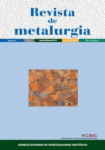
REVISTA DE METALURGIA
Unlocking the secrets of metals and alloys since 1968.REVISTA DE METALURGIA, published by the CONSEJO SUPERIOR INVESTIGACIONES CIENTIFICAS-CSIC in Spain, stands as a significant open-access journal since 1995 that focuses on the fields of condensed matter physics, materials chemistry, and the study of metals and alloys. With an ISSN of 0034-8570 and an E-ISSN of 1988-4222, this journal aims to disseminate innovative research findings and reviews that contribute to the understanding and advancement of metallurgical science. Although currently ranked in the fourth quartile across several relevant categories in Scopus, including Materials Science and Physics, its commitment to open access promotes the wider distribution of knowledge in these fields, ensuring that emerging findings are accessible to researchers, industry professionals, and students alike. The journal covers research from its earliest issues in 1968, maintaining a continuous archive that enhances its contributions to the scientific community. For those passionate about the complexities of material properties and behaviors, REVISTA DE METALURGIA serves as a platform for impactful scholarship and collaborative advancement.
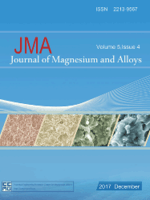
Journal of Magnesium and Alloys
Connecting Global Minds in Magnesium ResearchThe Journal of Magnesium and Alloys is a prestigious, peer-reviewed academic publication dedicated to advancing the field of materials science, particularly focusing on magnesium and its alloys. Published by KEAI PUBLISHING LTD since 2013, this Open Access journal enables unrestricted dissemination of research findings, enhancing global collaboration among researchers, professionals, and students. With an ISSN of 2213-9567 and a significant impact factor, it has established itself in the upper quartiles (Q1) of both the Mechanics of Materials and Metals and Alloys categories, ranking #3 out of 176 and #9 out of 398 respectively according to Scopus. The journal aims to provide a forum for the latest advances in the understanding, production, and application of magnesium alloys, fostering innovation and sustainable practices within the materials engineering community. Based in Beijing, China, the journal is committed to bridging gaps in current knowledge and driving future research directions through its high-quality publications.